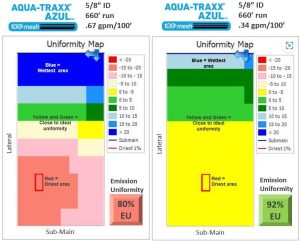From The Grand Junction Daily Sentinel (by Sam Waters)
In the back of almost every farm truck you are likely to find a pair of muddy irrigating boots. Stepping in the mud to shovel and straighten creases is common in the area, so getting muddy boots is just part of the job for most farmers. But one type of irrigation has the potential to get rid of some of the muck.
Subsurface drip (SDI) is a low-pressure, high-efficiency irrigation system that uses buried drip tubes or drip tape, essentially plastic tubing with holes in it, to meet crop water needs. This type of irrigation effectively waters the crops but keeps the surface dry. “The thing about this is that there is no run-off. If we do it correctly, there is no deep percolation. So essentially everything goes to the crop. So it’s very, very efficient,” said Calvin Pearson, research agronomist at the Colorado State University Fruita Agricultural Experiment Station.
Pearson and others at the experiment station installed an SDI system last spring with grant funding from the Colorado Water Conservation Board. Under the same grant, farmer Tom Landini installed a system last fall to water a small field of alfalfa. Both locations serve as demonstration systems to see how irrigation of this type would fit in with the cultural practices of the area.
While new to the Grand Valley, SDI technologies have been a part of irrigated agriculture since the 1960s. Although it can work for almost all crops, it is mostly widely used for high- value vegetable and fruit crops such as strawberries, tomatoes, cantaloupe and onions. “There could be significant use of subsurface drip irrigation for landscaping in the Grand Valley as well,” said Luke Gingerich, agricultural engineer with the Natural Resource Conservation Service.
SDI systems could help keep grass evenly watered, Gingerich said. And residents could water their lawn while mowing it with no problems.
This type of system is suitable for dry, hot and windy areas with limited water supply. The Grand Valley is not short on water, but SDI has potential to work well in the area.
Wayne Guccini, of the Mesa Conservation District, works with Gingerich to oversee the system at Landini’s farm. “It will work, it’s just a matter of whether it will be economically feasible,” Guccini said. And that’s the big concern. SDI systems can range from about $1,200 to $2,400 per acre to install, depending on what models are used, so a farmer investing that much capital will want to be sure it will pay off in the end.
“Who knows, there may be a time in this valley where we might not have the water that we have, so we might need a system like that widespread to keep things green,” Landini said.




